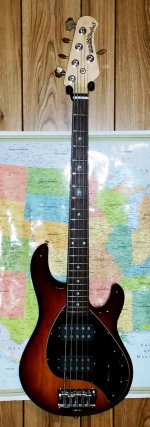You are using an out of date browser. It may not display this or other websites correctly.
You should upgrade or use an alternative browser.
You should upgrade or use an alternative browser.
- Thread starter JaredBT
- Start date
sanderhermans
Well-known member
Hello all, Im wondering why I cant seem to get my Stingray 5 to play like butter. Ive got the fretboard almost straight and my G string sattle is bottomed out. Could I need to shim the neck? Bought it new.
If you have followed the instructions on the ebmm website (under FAQ) and the action is still too high, then yes, it migt need a shim.
sanderhermans
Well-known member
Well im sure ebmm does not send out a bass that needs a shim or is set up poorly. So make sure you set it up to factory spec. Also this bass could have been sitting and played in the store for a long time. The fretboard does look like the bass has been played alot. Did you buy it in that condition?
`
A bass may be in-spec but not ready to
take a sooper-dooper set-up. So it ships,
but will not be eligible for warrantee work
to make it ready for the fussiest of set-up
mavens ... which includes me, and I take
it for granted that shimming is a routine
player's skill.
A bass may be in-spec but not ready to
take a sooper-dooper set-up. So it ships,
but will not be eligible for warrantee work
to make it ready for the fussiest of set-up
mavens ... which includes me, and I take
it for granted that shimming is a routine
player's skill.
Last edited:
OldManMusic
Well-known member
I got some from EBMM customer service - 3 sizes. Just call them and they'll hook you up.
Ok gotcha. What thickness shim do you recommend starting with?
This your first shimming job, so realize that you are learning as
you go, and please try not to feel impatient ... work carefully.
The neck might stick in the socket even after removing the six
screws. Wriggling it out creates angular movement that might
chip the finish at the thin edge on the treble side, so try not to
get into that action. Instead, if the neck is stuck, put the screws
back into their holes to about 1/4 inch shy of all the way down.
Use a wooden or plastic mallet, or use a small board over the
screw if all you have is a metal hammer. Tap evenly from screw
to screw to ease the neck out. If you can clearly identify excess
finish or any other source of the sticking problem, eliminate it,
cuz you'll prolly be removing the neck 2 or 3 times learning and
testing for the correct shim.
It's approximately a 10:1 ratio of neck motion to shim thickness,
where neck motion is measured as how far the nut "drops" vs
its previous position. You are lowering the nut for the reason you
would lower the saddles ... to lower the action.
One obvious idea is to start with the middle thickness of shim to
see if it's just right, or if you need less or more drop at the nut.
It's really impossible to recommend a thickness ... except to say
that in many typical cases, those who have no official factory
shims just start with a biz card and often enuf thaz just right.
Biz cards, being paper, may change thickness under pressure
over time. Therefor, more stable shims, plastic, aluminum, etc,
are preferred. Consumer packaging or disposable pie pans and
such are good sources at approx the correct thickness.
Repeat: Be careful and patient
Last edited:
EdrisMunden
Member
- Joined
- Sep 5, 2014
- Messages
- 6
This your first shimming job, so realize that you are learning as
you go, and please try not to feel impatient ... work carefully.
The neck might stick in the socket even after removing the six
screws. Wriggling it out creates angular movement that might
chip the finish at the thin edge on the treble side, so try not to
get into that action. Instead, if the neck is stuck, put the screws
back into their holes to about 1/4 inch shy of all the way down.
Use a wooden or plastic mallet, or use a small board over the
screw if all you have is a metal hammer. Tap evenly from screw
to screw to ease the neck out. If you can clearly identify excess
finish or any other source of the sticking problem, eliminate it,
cuz you'll prolly be removing the neck 2 or 3 times learning and
testing for the correct shim.
It's approximately a 10:1 ratio of neck motion to shim thickness,
where neck motion is measured as how far the nut "drops" vs
its previous position. You are lowering the nut for the reason you
would lower the saddles ... to lower the action.
One obvious idea is to start with the middle thickness of shim to
see if it's just right, or if you need less or more drop at the nut.
It's really impossible to recommend a thickness ... except to say
that in many typical cases, those who have no official factory
shims just start with a biz card and often enuf thaz just right.
Biz cards, being paper, may change thickness under pressure
over time. Therefor, more stable shims, plastic, aluminum, etc,
are preferred. Consumer packaging or disposable pie pans and
such are good sources at approx the correct thickness.
Repeat: Be careful and patient
i agree with you...i am gonna keep this for the next time when i am going to have the shim...



